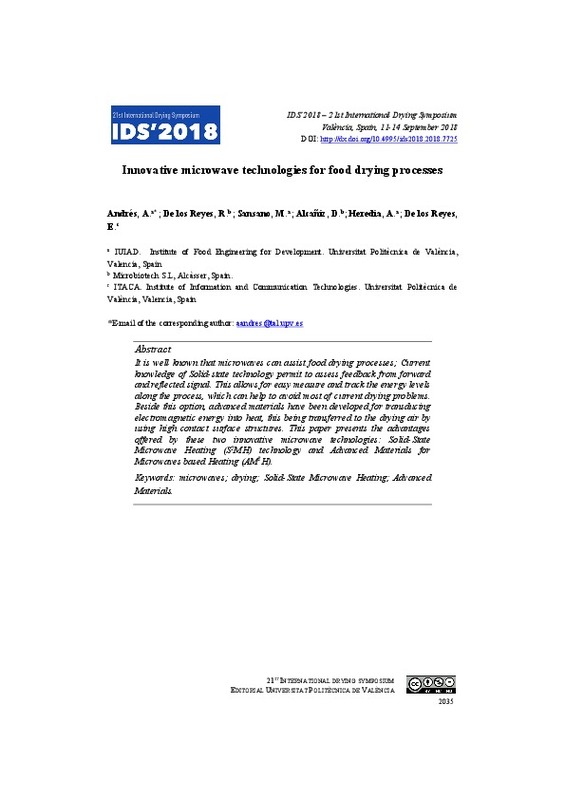JavaScript is disabled for your browser. Some features of this site may not work without it.
Buscar en RiuNet
Listar
Mi cuenta
Estadísticas
Ayuda RiuNet
Admin. UPV
Innovative microwave technologies for food drying processes
Mostrar el registro sencillo del ítem
Ficheros en el ítem
| dc.contributor.author | Andres, Ana
|
es_ES |
| dc.contributor.author | Reyes, Ruth
|
es_ES |
| dc.contributor.author | Sansano, Mariola
|
es_ES |
| dc.contributor.author | Alcañiz, D.
|
es_ES |
| dc.contributor.author | Heredia, Ana
|
es_ES |
| dc.contributor.author | Reyes, Elias
|
es_ES |
| dc.date.accessioned | 2019-03-20T10:06:23Z | |
| dc.date.available | 2019-03-20T10:06:23Z | |
| dc.date.issued | 2018-09-07 | |
| dc.identifier.isbn | 9788490486887 | |
| dc.identifier.uri | http://hdl.handle.net/10251/118221 | |
| dc.description.abstract | [EN] It is well known that microwaves can assist most of food drying processes; but despite its benefits, microwave energy has not yet been exploited to its potential in the industrial applications. Some of the reasons are because available microwave technology (tubes and valves) cannot offer a homogeneous heating, causing hot/cold spots depending on product geometry and distribution in the chamber or tunnel. Particularly in drying processes, when available water decreases, the efficiency of the process will decrease. If the microwave power is not adjusted at this point of the drying process, the electromagnetic field strength increases and thermal runaway, arcing, or plasma formation can be created. Currently, the solid-state microwave heating (S2MH) technology is considered one of the most promising options to avoid the ancient problems preserving the known advantages. The new S2MH features include frequency and phase variability and control, low input-voltage requirements, compactness and rigidity, reliability, and better compatibility with other electronic possibilities (Internet-of-Things). The first notable advantaged is the S2MH system ability to assess feedback from forward and reflected signal. This allows the application to easily measure and track the energy levels being put into the load, which can avoid the mentioned final drying problem, together with many others related to monitoring needs. On the other hand, almost all energy consumption and CO2 generation in drying processes correspond to air heating stage. To tackle this problem, Advanced Materials for Microwaves based Heating (AM2H) have been developed for transducing electromagnetic energy into heat, which is transferred to air by using high contact surface ceramic structures. The aim of this work is to review Microwaves Assisted Drying Processes and to present the advantages offered by two innovative microwave technologies: Solid-State Microwave Heating (S2MH) technology and Advanced Materials for Microwaves based Heating (AM2H). | es_ES |
| dc.format.extent | 8 | es_ES |
| dc.language | Inglés | es_ES |
| dc.publisher | Editorial Universitat Politècnica de València | es_ES |
| dc.relation.ispartof | IDS 2018. 21st International Drying Symposium Proceedings | es_ES |
| dc.rights | Reconocimiento - No comercial - Sin obra derivada (by-nc-nd) | es_ES |
| dc.subject | Drying | es_ES |
| dc.subject | Dehydration | es_ES |
| dc.subject | Dewatering | es_ES |
| dc.subject | Emerging technologies | es_ES |
| dc.subject | Products quality | es_ES |
| dc.subject | Process control | es_ES |
| dc.subject | Environmental | es_ES |
| dc.subject | Evaporation | es_ES |
| dc.subject | Sublimation | es_ES |
| dc.subject | Diffusion | es_ES |
| dc.subject | Energy | es_ES |
| dc.subject | Intensification | es_ES |
| dc.subject | Microwaves | es_ES |
| dc.subject | Solid-state | es_ES |
| dc.subject | Microwave heating | es_ES |
| dc.subject | Advanced materials | es_ES |
| dc.title | Innovative microwave technologies for food drying processes | es_ES |
| dc.type | Capítulo de libro | es_ES |
| dc.type | Comunicación en congreso | es_ES |
| dc.identifier.doi | 10.4995/IDS2018.2018.7725 | |
| dc.rights.accessRights | Abierto | es_ES |
| dc.description.bibliographicCitation | Andres, A.; Reyes, R.; Sansano, M.; Alcañiz, D.; Heredia, A.; Reyes, E. (2018). Innovative microwave technologies for food drying processes. En IDS 2018. 21st International Drying Symposium Proceedings. Editorial Universitat Politècnica de València. 2035-2042. https://doi.org/10.4995/IDS2018.2018.7725 | es_ES |
| dc.description.accrualMethod | OCS | es_ES |
| dc.relation.conferencename | 21st International Drying Symposium | es_ES |
| dc.relation.conferencedate | Septiembre 11-14, 2018 | es_ES |
| dc.relation.conferenceplace | Valencia, Spain | es_ES |
| dc.relation.publisherversion | http://ocs.editorial.upv.es/index.php/IDS/ids2018/paper/view/7725 | es_ES |
| dc.description.upvformatpinicio | 2035 | es_ES |
| dc.description.upvformatpfin | 2042 | es_ES |
| dc.type.version | info:eu-repo/semantics/publishedVersion | es_ES |
| dc.relation.pasarela | OCS\7725 | es_ES |








